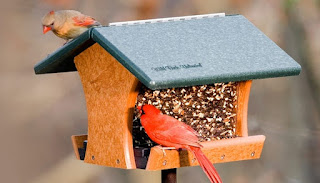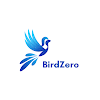Bird feeders are a delightful addition to any backyard, offering a window into the avian world and providing sustenance to our feathered friends. In this comprehensive guide, we'll delve into the top three bird feeders that are popular among bird enthusiasts and discuss their features, benefits, and considerations. Whether you're a seasoned birder or just starting out, these feeders can enhance your bird-watching experience and attract a diverse array of bird species to your outdoor space.
1. Tube Feeders:
**Description:**
Tube feeders are cylindrical in shape and typically made of plastic or metal. They feature multiple feeding ports along their length, allowing several birds to feed simultaneously. The design of tube feeders helps protect the seeds from moisture and keeps themhttps://www.cpmrevenuegate.com/mh8s0s9f?key=0aed7522c6a7ac46ed82f931b32509a6 fresh for longer periods.
**Features:**
- Multiple feeding ports: Tube feeders can accommodate several birds at once, making them ideal for busy feeding stations.
- Seed protection: The enclosed design of tube feeders protects the seeds from rain, snow, and other elements, keeping them dry and fresh.
- Adjustable perches: Some tube feeders come with adjustable perches that can accommodate different bird species, including small and large birds.
- Easy to clean: Many tube feeders have removable parts, making them easy to clean and maintain.
**Benefits:**
- Attracts a variety of birds: Tube feeders are versatile and can attract a wide range of bird species, including finches, chickadees, sparrows, and more.
- Weather-resistant: The design of tube feeders helps protect the seeds from weather damage, ensuring that birds have access to food even during inclement weather.
- Low maintenance: With their easy-to-clean design, tube feeders require minimal maintenance, allowing you to focus more on enjoying bird watching.
**Considerations:**
- Seed spillage: Some tube feeders may experience seed spillage if not properly maintained or filled. Choose a feeder with a built-in seed catcher to minimize waste.
- Squirrel deterrents: To prevent squirrels from accessing the feeder, consider adding squirrel-proof features such as baffles or cages.
2. Platform Feeders:
**Description:**
Platform feeders, also known as tray feeders, are flat surfaces typically mounted on poles or hung from trees. They provide an open feeding area where birds can easily access seeds, nuts, fruits, and other treats. Platform feeders are suitable for ground-feeding birds and species that prefer a clear view of their surroundings while feeding.
**Features:**
- Open design: Platform feeders offer a wide, open space for birds to feed, making them suitable for ground-feeding species like cardinals, jays, doves, and sparrows.
- Versatility: You can offer a variety of bird foods on platform feeders, including seed mixes, suet, fruits, and mealworms, attracting a diverse range of bird species.
- Easy access: Birds can easily land on the platform and access the food without obstruction, making platform feeders user-friendly for both birds and bird watchers.
- Drainage holes: Many platform feeders have drainage holes to prevent water accumulation, ensuring that the food stays dry and fresh.
**Benefits:**
- Attracts ground-feeding birds: Platform feeders are particularly attractive to ground-feeding birds that may not visit elevated feeders like tube or hopper feeders.
- Versatile food options: You can customize the food offerings on platform feeders to cater to different bird species and their dietary preferences.
- Easy monitoring: The open design of platform feeders allows for easy monitoring of feeding activity and bird behavior.
**Considerations:**
- Exposure to weather: Since platform feeders are open, they may expose the food to rain, snow, and other weather conditions. Choose feeders with proper drainage and cover options to protect the food.
- Cleaning requirements: Regular cleaning is essential for platform feeders to prevent the buildup of mold, bacteria, and waste. Opt for feeders with removable trays or easy-access cleaning features.
3. Hopper Feeders:
**Description:**
Hopper feeders, also known as house feeders, are box-shaped feeders with a roof or cover to protect the food from the elements. They typically have a large seed capacity and dispense seeds gradually as birds feed, reducing the frequency of refills. Hopper feeders are favored by many bird enthusiasts for their convenience and ability to attract a wide range of bird species.
**Features:**
- Large seed capacity: Hopper feeders can hold a significant amount of seeds, reducing the need for frequent refills, especially in busy feeding areas.
- Roof or cover: The roof or cover of hopper feeders protects the seeds from rain, snow, and sun exposure, keeping them fresh and dry.
- Gravity-fed dispensing: As birds feed from the bottom tray, more seeds automatically flow down from the hopper, ensuring a steady supply of food.
- Adjustable perches: Some hopper feeders have adjustable perches to accommodate different bird sizes and feeding preferences.
**Benefits:**
- Extended refill intervals: The large seed capacity of hopper feeders means less frequent refills, making them convenient for busy bird watchers or those with multiple feeders.
- Alluring to many birds: Hopper feeders attract a wide variety of bird species, including cardinals, grosbeaks, jays, woodpeckers, and more, thanks to their design and ample food supply.
- Weather protection: The roof or cover of hopper feeders shields the food from weather elements, ensuring that birds have access to fresh seeds regardless of outdoor conditions.
**Considerations:**
- Cleaning challenges: Hopper feeders may be more challenging to clean compared to tube or platform feeders due to their design and larger size. Look for feeders with removable parts or easy-access cleaning features.
- Seed waste: Birds may flick or scatter seeds from hopper feeders, leading to some waste. Consider placing the feeder in an area where spilled seeds can be easily cleaned or where ground-feeding birds can forage.
Conclusion:
In summary, tube feeders, platform feeders, and hopper feeders each offer unique benefits and considerations for backyard bird watching. Tube feeders are versatile and weather-resistant, attracting a variety of birds with minimal maintenance. Platform feeders cater to ground-feeding species and allow for versatile food options. Hopper feeders, with their large seed capacity and weather protection, are convenient for busy bird enthusiasts.
When choosing a bird feeder, consider factors such as the bird species you want to attract, your local weather conditions, maintenance requirements, and feeder placement. By selecting the right feeder and providing quality bird food, you can create a welcoming environment for birds and enhance your enjoyment of bird watching in your backyard.









0 Comments